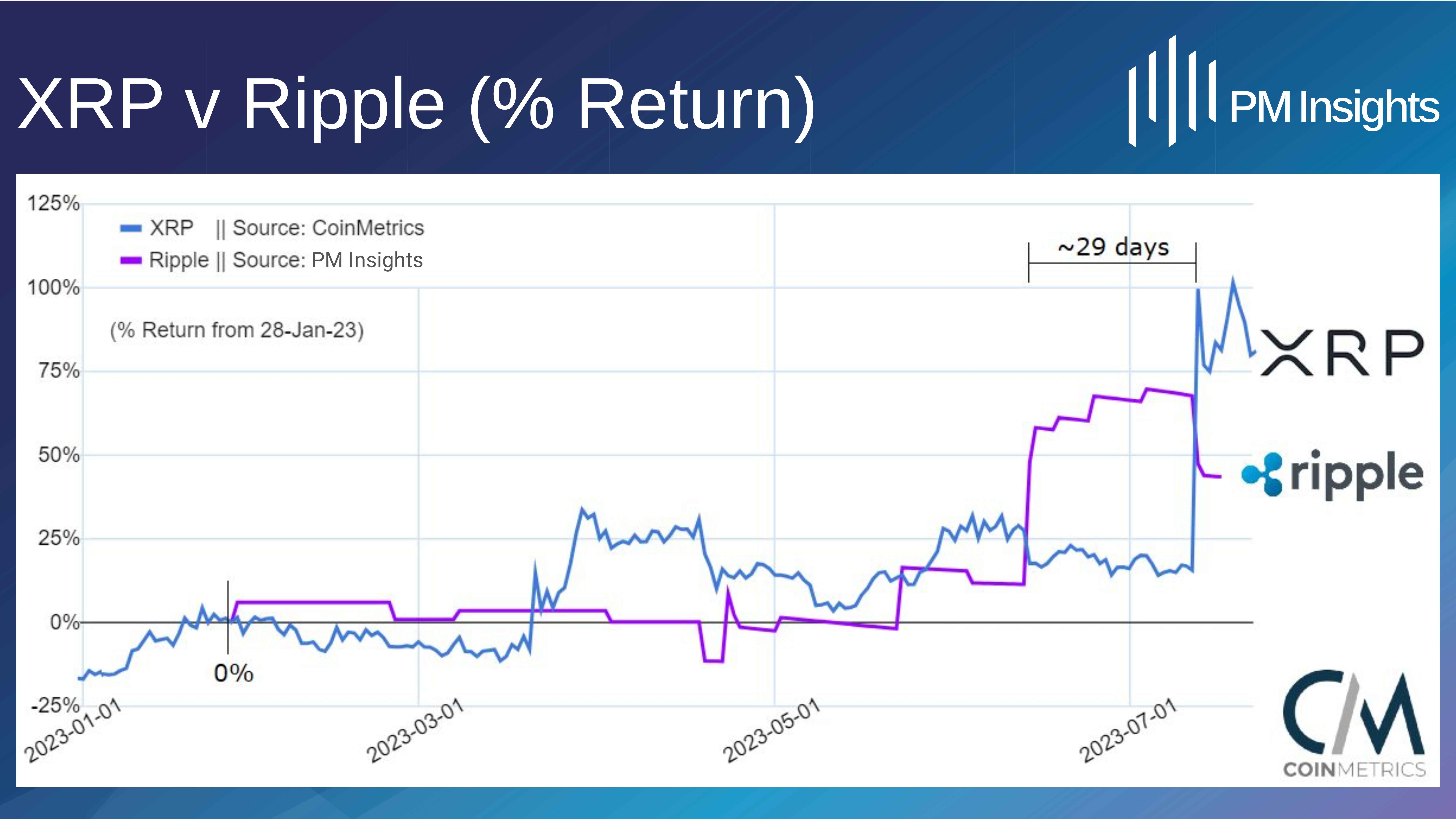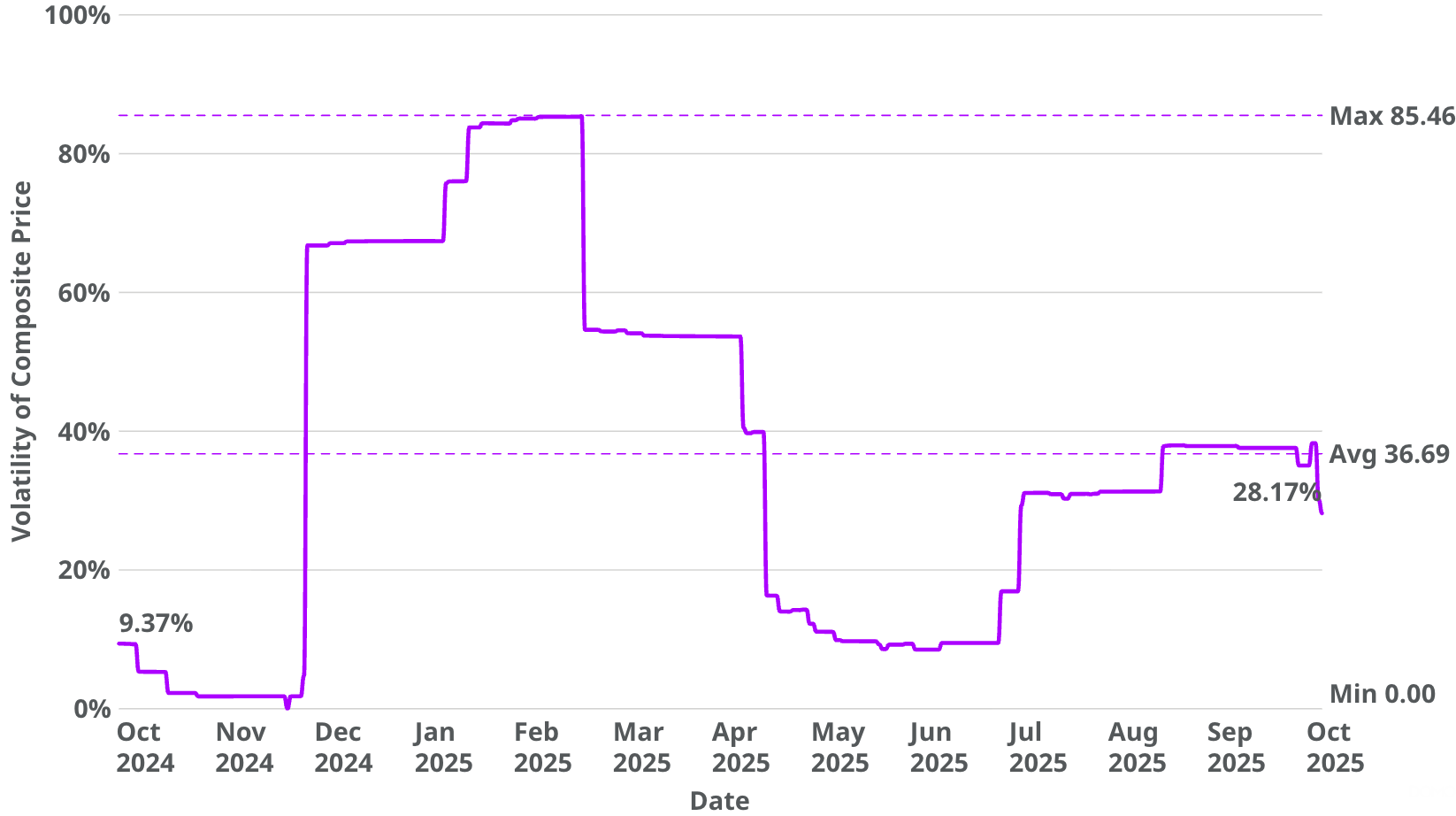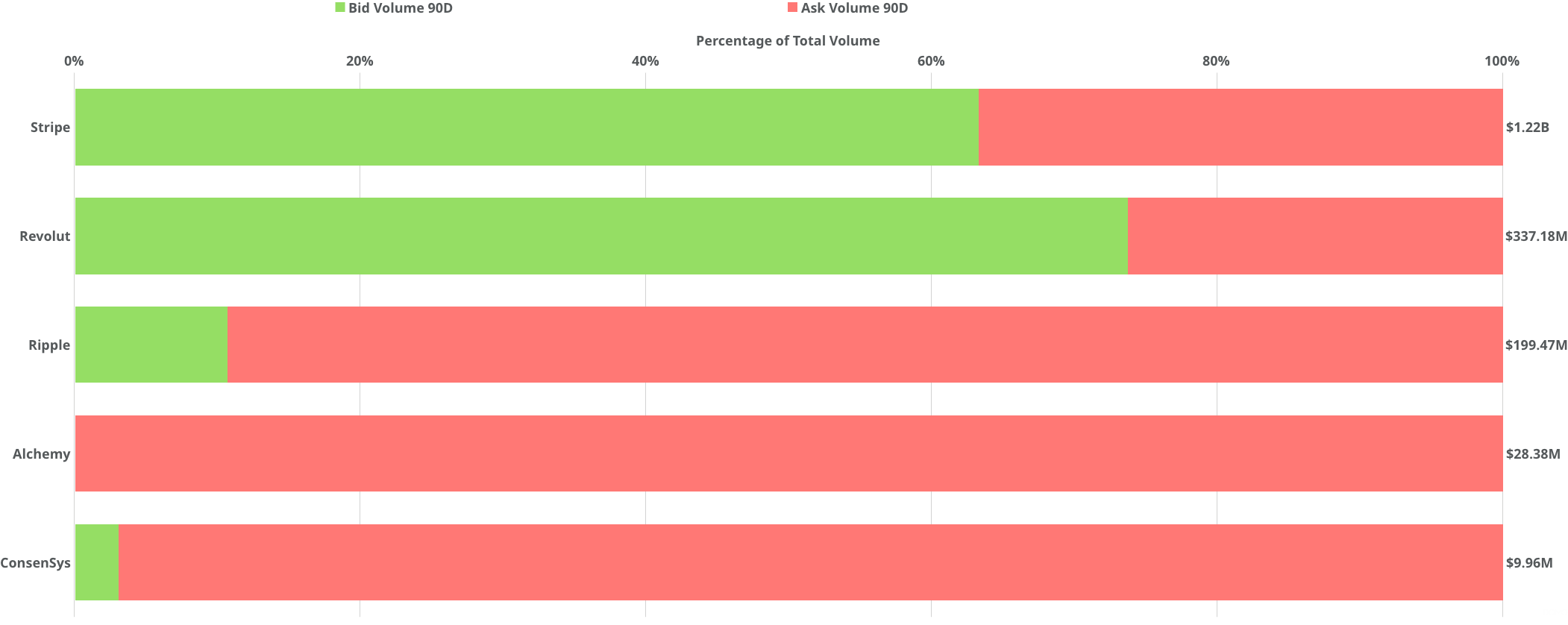.jpg)
Ripple’s post-settlement comeback gains traction with Middle East expansion
Weekly Edition & Stock Spotlight
October 13, 2025

|| October 13, 2025
PM Insights provides independent, market-driven data for Private Growth and Pre-IPO companies, providing unparalleled transparency and helping asset managers, consultants, banks, and regulators understand trading conditions and risk in this dynamic market.
This report provides an in-depth assessment of Ripple’s evolving position within global payment infrastructure and digital asset markets, focusing on the company’s post-settlement resurgence and expanding institutional strategy. It highlights Ripple’s progress in building regulated payment rails, liquidity solutions, and stablecoin infrastructure, including the launch of RLUSD and its pursuit of a U.S. banking charter. Drawing on insights from PM Insights’ collaboration with Coin Metrics, the report also references the relationship between Ripple’s private-market valuation and XRP’s network performance as an indicator of institutional confidence in regulated blockchain finance. Together, these developments illustrate Ripple’s growing role in shaping the future of cross-border payments and enterprise digital-asset adoption
Key Takeaways
- Strong Return on Investment (ROI): Ripple delivered impressive gains of +100.64%, +52.60%, and +18.22% over the past 180, 90, and 30 days, respectively
- Valuation Momentum: Ripple’s implied valuation has increased 130% since its Series C funding round
- Robust Secondary Market Activity: Ripple posted the highest bid and ask volume in Q1 2024, totaling $400.15 million
- Elevated Price Volatility: Ripple recorded the highest year-to-date average composite price volatility of 41.02% within its comparable group

ROI Private & Public
|| ROI from December 31, 2024 until October 13, 2025.
.jpg)
The PM50 Growth tracks the performance of the 50 most active private names observed in the secondary market. It is an equal-weighted index, rebalanced on a monthly basis.
This rebalancing of constituents over time gives way for more active names to participate in what we observe as "market performance," and in a more appropriate manner than static selections and weightings criteria.
Most Active Names Performance Across All Sectors
Data as of October 13, 2025.
90D Return △ - Trend of return on composite price
90D % △ - Change in composite price in terms of percentage
Implied Mkt Cap* - Implied market capitalization based on composite price
90D Implied Mkt △ - Change in implied market capitalization
.jpg)

Stock Spotlight - Ripple
.png)
Sectors
DeFi Blockchain Financial Payments
Headquarters
San Francisco, California, USA
CEO
Bradley Kent Garlinghouse
"Building the Internet of Value”
Ripple is a blockchain infrastructure company that provides enterprise-grade payment solutions for financial institutions worldwide. Founded in 2012 and headquartered in San Francisco, Ripple has become a leading provider of blockchain-based cross-border payment and liquidity solutions.
In 2025, the company resolved its multi-year legal dispute with the U.S. Securities and Exchange Commission through a $50 million settlement that confirmed XRP’s non-security status for public exchange sales. The resolution lifted long-standing regulatory uncertainty and coincided with a sharp rebound in XRP prices and liquidity, signaling renewed institutional confidence in Ripple’s network and global payments platform.
Cross-asset correlation case study using PM Insights data: Ripple
Ripple was featured in a case study developed in collaboration with Coin Metrics and PM Insights (formerly ApeVue). The analysis focused on mid-2023, a pivotal period when Ripple’s secondary-market pricing began to re-rate ahead of its partial legal victory against the SEC, signaling anticipatory positioning among traders and private-market investors.
PM Insights’ analysis of private-market activity showed that Ripple’s secondary-market stock price climbed more than 40 percent in the weeks before the ruling, reflecting expectations that a favorable decision would remove long-standing regulatory uncertainty and reopen institutional pathways for XRP adoption. When the court confirmed that public exchange sales of XRP did not constitute securities transactions, the reaction across crypto markets was swift. XRP rallied more than 70 percent within days, reaching a 12-month high as previously sidelined retail and institutional demand returned.
By integrating Coin Metrics’ on-chain data with PM Insights’ private-market pricing analytics, the study identified a clear lead-lag relationship of roughly 29 days. Ripple’s secondary-market activity moved first, anticipating the outcome, while XRP’s on-chain performance followed once the ruling became public.
This sequence shows how alternative datasets that combine private-market pricing and blockchain activity can reveal early shifts in sentiment before they appear in public markets. For investors, the insight is clear. Monitoring Ripple’s secondary-market pricing provided a leading signal for XRP’s breakout, illustrating how information at the intersection of private and digital assets can uncover opportunities in emerging market structures.

Business Model
Ripple generates revenue through XRP-related activities, enterprise software licensing, and transaction fees from its global RippleNet infrastructure. The company's core offerings include payment processing solutions, XRP-based liquidity products for cross-border settlements, and standardized APIs that enable financial institutions to execute low-cost international transfers. RippleNet participants pay usage-based fees tied to transaction volume, creating a scalable recurring revenue stream.
Beyond network operations, Ripple earns returns from strategic investments in blockchain and fintech ventures, and through its Line of Credit product, which provides on-demand liquidity for cross-border payments. The company has expanded its ecosystem with RLUSD, a U.S. dollar-backed stablecoin issued in partnership with BNY Mellon, and is broadening into institutional custody and digital asset management services. These initiatives diversify Ripple's revenue base beyond XRP sales, building a more resilient business model aligned with traditional financial institutions entering the digital asset space.
Scale and Growth
Ripple has established itself as a leading global provider of blockchain-based payment and settlement solutions, operating in over 55 countries and serving a network of financial institutions through its RippleNet and On-Demand Liquidity (ODL) platforms. As of 2025, XRP ranks among the world’s top five digital assets, with a market capitalization of approximately $126 billion. Trading activity remains robust, with average daily XRP volumes reaching about $3.2 billion in Q1 2025. On-chain participation is accelerating - active addresses on the XRP Ledger grew 142% quarter-over-quarter, alongside a 12% increase in new account creation. Ripple’s expansion is also fueled by strategic moves such as the $1.25 billion acquisition of prime broker Hidden Road, which enhances its multi-asset liquidity and institutional infrastructure capabilities. Together, these developments reflect Ripple’s increasing scale, deepening institutional integration, and strong positioning within the evolving cross-border payments ecosystem.
Competitive Edge
<row>
<col>
The blockchain payments sector stratifies into point solutions and integrated platforms. Ripple leads the latter category with its unified infrastructure for real-time settlements, digital asset custody, and stablecoin liquidity, appealing to banks and enterprises seeking compliance-first tooling. Stellar and SWIFT occupy specialized niches in remittances and legacy messaging, respectively, while IBM Blockchain and Algorand cater to enterprises via tokenization and smart contracts but lack payment-specific optimization. Ripple’s dominance in institutional adoption stems from its dual focus on technical scalability and regulatory alignment, positioning it uniquely to serve evolving demands for programmable finance.
</col>
<col>

</col>
</row>
<row>
<col>
Targeted Impact
Ripple aims to enable instant, low-cost global payments, fostering financial inclusion and efficiency across international markets.
</col>
<col>
.png)
</col>
<col>
What Comes Next?
Ripple is applying for OCC banking licenses, launching RLUSD in international markets, and expanding institutional custody offerings.
</col>
</row>
<row>
<col>
.png)
</col>
<col>
Who will benefit?
Financial institutions, payment service providers, and global remittance companies benefit from Ripple’s blockchain-based solutions.
</col>
<col>
.png)
</col>
</row>
Ripple's Timeline
.png)
Bull and Bear Case
<row>
<col>
.png)
</col>
<col>
.png)
</col>
</row>
<row>
<col>
Market Opportunity & Expansion
- Cross-border payments are a large, growing pool: global cross-border payments revenue ~$212.55B in 2024, projected ~$320.73B by 2030 (7.1% CAGR)
- Non-bank players are winning share, creating openings for crypto rails: up to 65% of 2024 international Peer-to-Peer (P2P) value captured by nontraditional providers
</col>
<col>
Market Risks & Competitive Threats
- Intense competition from established and new rails as nontraditional players capture large P2P cross-border share
- Payments growth moderating (global payments revenue growth slowed to 4% in 2024), potentially tempering adoption velocity
</col>
</row>
<row>
<col>
Competitive Advantages & Defensibility
- Regulatory footholds and market entry: Dubai license followed by UAE clients Zand Bank and Mamo for Ripple Payments
- Expansion into institutional finance: Ripple acquired prime broker Hidden Road for $1.25 billion to strengthen its services across multiple asset classes
</col>
<col>
Regulatory or Structural Headwinds
- RLUSD remains small relative to dominant stablecoins, with a market cap of ~$840M in October, 2025 versus USDT at ~$179B and USDC at ~$76B, underscoring limited scale and network effects
- Rising structural pricing pressure: Non-bank payment providers now charge up to 80% less than traditional institutions, reshaping cross-border economics and compressing margins for new entrants
</col>
</row>
<row>
<col>
Financial Performance & Unit Economics
- Deep liquidity around the asset: XRP averaged ~$3.2 billion in daily volume on major exchanges during Q1 2025, reflecting strong market participation
- Rapid network growth: XRPL daily active addresses surged 142% QoQ to ~134.6K in Q1 2025, showing expanding on-chain engagement.
</col>
<col>
Financial Sustainability Concerns
- Regulatory fines underscore fragility:The $125M SEC penalty and associated injunctions emphasize continued legal risk even after settlement
- Shifting global policy landscape: Emerging U.S. legislation like the GENIUS Act and the CLARITY Act aims to tighten oversight of digital assets, which could reshape Ripple’s compliance and disclosure requirements
</col>
</row>
<row>
<col>
Strategic Positioning & Optionality
- Regional expansion to new corridors (e.g., Bahrain via Bahrain FinTech Bay partnership) to pilot cross-border and tokenization use cases
- Growing product lineup: RLUSD stablecoin rollouts (Africa partners incl. Chipper Cash, VALR, Yellow Card)
</col>
<col>
Valuation & Timing Risks
- ETF / regulatory dependency for upside valuation: Many analyst models projecting XRP at $4–$5 by end-2025 assume robust spot XRP ETF inflows and favorable macro conditions; delays or rejections in regulatory approval could significantly suppress near-term multiples
- High timing risk from crypto volatility and deleveraging: Recent heightened volatility and liquidation events in crypto markets elevate execution risk for capital raises, institutional allocations, or XRP-linked products repricing
</col>
</row>
Prominent News
Ripple expands into the Kingdom of Bahrain through Strategic Partnership with Bahrain Fintech Bay, October 9, 2025 - Ripple announced a strategic partnership with Bahrain Fintech Bay to expand its presence in the Middle East and advance blockchain, payments, and digital asset initiatives in the region. Click here to read more.
Ripple CTO David Schwartz to step down amid crypto payments competition, October 1, 2025 - Ripple’s CTO, David Schwartz, is stepping down amid intensifying competition in the crypto payments space, signaling a leadership shift at the company. Click here to read more.
Ripple and i-payout Partner to Deliver a New Standard in Cross-Border Payout Infrastructure, September 29, 2025- Ripple partnered with i-payout to enhance real-time cross-border payments in the U.S. and Canada, aiming to improve speed, transparency, and reliability for enterprise payouts. Click here to read more.
Return on Investment (ROI)
The graph below displays Ripple's ROI over the past 180, 90, and 30 days, computed as of October 13, 2025.
- 180D: ↑ +100.64% since April 17, 2025
- 90D: ↑ +52.60% since July 16, 2025
- 30D: ↑ +18.22% since September 14, 2025

Funding Round in USD
- Primary Funding Round: Ripple raised $200 million in Series C on December 20, 2019, at a $10 billion valuation and a share price of $61.49
- Investors: Series C saw participation from Route 66 Ventures, Sbi Holdings and Tetragon Financial Group Limited
- Current Implied Valuation: $23 billion on October 13, 2025, according to PM Insights
- Change Since Last Primary Round: Up 130% from its Series C valuation
<row>
<card>
Primary Round Valuation
<span class="date">2019-12-20</span>
<span class="value">$10B</span>
</card>
<card>
Implied Valuation
<span class="date">2025-10-13</span>
<span class="value">$23B</span>
</card>
<card>
Change Since Last Round
<span class="date">2019-12-30 → 2025-10-13</span>
<span class="value green">+130%<span>
</card>
</row>

Quarterly Bid:Ask Volume Ratio
PM Insights highlights the quarterly bid:ask volume ratio of Ripple where there were at least three institutionally-sized broker contributions within that period. The stacked bar chart below shows the total quarterly bid and ask volumes alongside their relative ratios.
- Highest volume: $400.15 million in Q1 2024
- Lowest volume: $16.11 million in Q4 2023
- Largest bid-side activity: 77% of $146.16 million in Q2 2025
- Largest ask-side activity: 100% of $51.20 million in Q1 2023

Volatility of Composite Price
The volatility of the composite price is calculated based on price movements within a 90-day rolling window ending on each respective date. The graph below illustrates the trend in volatility of composite price for Ripple for a one year period from October 14, 2025 until October 13, 2025.
- Volatility began at 9.37% in October 2024 and it dropped to its lowest point of 0% at the beginning of December 2024
- It then rose sharply shortly after, climbing above 60% and peaking at 85.46% in March 2025
- After reaching its peak, volatility declined sharply to about 54.64%, stayed relatively low through mid-2025, and then rose modestly, finishing the period at 28.17% on October 13, 2025

Ripple's Private Comparables
PM Insights highlights four private companies, all active as of October 13, 2025, that are close competitors of Ripple. These companies either focus on blockchain-based payment processing or specialize in digital asset infrastructure and custody services.
90D Bid and Ask Volume Ratio
The stacked bar chart below illustrates the bid and ask volume ratios for the period from July 16, 2025, to October 13, 2025, showing only companies with at least 3 contributions.
- Highest volume: Stripe, $1.22 billion
- Lowest volume: Consensys, $9.96 million
- Largest bid-side activity: Revolut, 74% of $337.18 million
- Largest ask-side activity: Alchemy, 100% of $28.38 million

Change in Composite Price
The bar chart below illustrates the 90-day change in composite prices for the period from July 16, 2025, to October 13, 2025.
- Strongest gain: Consensys' composite price rose by +58.43% from $26.35 to $41.75
- Weakest return: Alchemy's composite price fell -15.58% from $221.88 to $187.32
- Ripple also posted notable growth, with its composite price climbing 52.60%, from $92.70 to $141.45

YTD Average Volatility of Composite Price
The volatility of the composite price is calculated based on price movements within a 90-day rolling window ending on that date. The bar chart below displays the mean volatility from January 1, 2025 until October 13, 2025.

Ready to see it in action?
Schedule a demo with one of our experts
.jpg)
.jpg)
.jpg)
.jpg)
.jpg)
.jpg)
.jpg)
.jpg)
.jpg)
.jpg)
.jpg)
